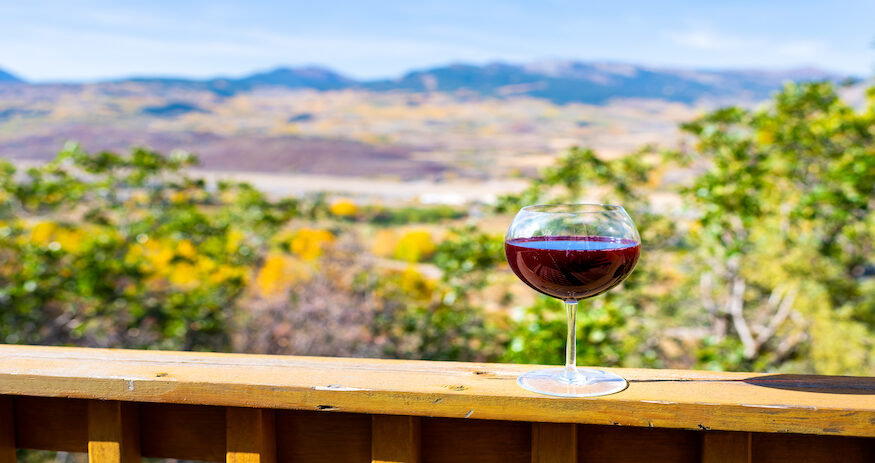Exploring the Riches of Colorado’s Wine Country: A Journey Through Vineyards and Vintages (COBIZ)
Jamie Siebrase
April 9, 2024

Inside Colorado's wine renaissance and its scenic vineyards.
Perched above the Colorado River, surrounded by Palisade’s prized peach orchards, you’ll discover Restoration Vineyards, where co-owners Linda and Gary Brauns grow six varieties of grapes across 10 acres opening to stellar views of the Book Cliffs. Nestled in the vines there’s a winery, tasting room and expansive lawn — the perfect place to watch the sunset while sipping Sauvignon Blanc, or maybe a glass of Barbera, their flagship red.
It’s not Napa, but that’s a plus for tourists demanding a novel wine-tasting experience. Colorado’s arid landscape offers an incredible setting for wine lovers, says Kevin Webber, CEO of Carboy Winery, Colorado’s largest sparkling facility.
Attesting to the area’s natural beauty, USA Today named Carboy’s Palisade tasting room (one of four the company runs statewide) the sixth-best wine-tasting room in the country in 2023.
Beyond the landscape, a uniquely Colorado experience enhances local vino. Many area wineries, Restoration and Carboy included, incorporate all elements of winemaking into the customer experience, from growing and harvesting to processing, aging, production — and tasting, of course. “We include hands-on learning as much as possible,” adds Linda Brauns.
Technically, craft beer has never been the state’s only local pour. Colorado’s wine-production industry dates back to 1890, when former Colorado Governor George A. Crawford planted 60 acres of wine grapes near Palisade. The industry didn’t really take off, though, until the following century, with legislation in 1977 and 1990 permitting small farm wineries and establishing the Colorado Wine Industry Development Board, respectively.
John Garlich and Ulla Merz, co-owners of Bookcliff Farms, came to the scene in 1996 and have seen the development of Colorado’s wine industry firsthand. From a handful of wineries in the 1990s, the industry has grown to include more than 170 licensed wineries, including 25 cideries and 16 meaderies, plus a sake producer, according to the Colorado Wine Industry Development Board, which is housed under the Colorado Department of Agriculture.
Last year, Garlich and Merz sold the winemaking portion of their business, Bookcli Vineyards, with tasting rooms in Palisade and Boulder, but they’ve continued farming on the Western Slope.
“In the beginning, enthusiasm carried us,” Merz says, thinking back to the 1990s, recalling a tight-knit group of dentists, geologists and engineers (like Garlich) who’d been pulled to the region by a common passion. “We’ve since attracted business-oriented professionals and trained winemakers,” Merz adds.
Fresh blood led to an increase in quality. Wine Enthusiast recently reviewed 21 Colorado wines that received an average score of 88.2. Seven wines received 90 points or higher, including BookCli Vineyards’ 2019 Reserve Merlot (91 points) and Carboy Winery’s 2019 Malbec (90 points). Winery at Holy Cross Abbey in Cañon City raked in several 90-plus scores. “We’ve made huge strides in classic wines,” says Merz, noting, “The industry here is very receptive to innovation.”
Maybe it’s the trifecta of passion, quality and innovation that explains how Colorado has managed to climb the ranks as a top wine destination. Hu Post listed the Grand Valley as a top U.S. wine destination; the inflight magazine Hemispheres dubbed Palisade a wine region to watch; Wine Enthusiast named The Infinite Monkey Theorem one of the best urban wineries in the U.S.; and Forbes noted the economic growth the wine industry has brought to Colorado.
Colorado grapes hold their own secrets.
It’s the combination of climate, soil and the environment that makes any wine special, explains Horst Caspari, state viticulturist and professor at CSU’s Western Colorado Research Center. “The place a wine is from has a certain expression that can’t be copied anywhere else,” Horst says.
In Colorado, a drier, mild-temperature climate paves the way for one-of-a-kind grapes.
“It’s a misconception that Colorado is a cold-climate grape-growing region,” Jayme Henderson says. She and her husband Steve Steese co-own The Storm Cellar, a boutique winery in Hotchkiss. (In case you’re curious, Henderson clarifies, “The challenges our region experiences surround our compact grape-growing season. We struggle, at times, to get our grapes ripe in time.”)
Mountainous terrain, Henderson continues, channels wind to deliver a warming effect. Local grapes also benefit from drastic diurnal temperature swings that preserve acidity within the grapes, leading to flavorful wines that are crisp and refreshing.
Speaking of acidity, Colorado’s soils are generally more alkaline than the acidic soils of California. Local Merlots might taste like Bordeaux, and Colorado Syrahs can seem closer to Rhône Valley reds than Australian Shiraz. Suffice to say, Centennial State wines taste uniquely Colorado.
Local grape growing regions range in elevation from 4,000 to 7,000 feet, making them the highest in the northern hemisphere.
In addition to elevation, Colorado has sunshine — plenty of it. “The region’s UV intensity produces smaller berries with thicker skins,” Steese says, adding, “The growing season is short, but intense.”

